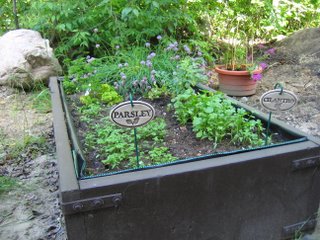
Currently, I am in the spring manic phase of seed starting. I am
planting far more seeds than I could ever grow, and potting up as many seedlings as I could possibly have room for. Some seeds germinate easier than others. As yet, my Pulsatilla, Cleome, and Campanula carpatica have been a no-go. Currently, they are sitting on the garage window sill in hopes that fluctuating temperatures might help do the trick. The only thing that is growing in these pots so far is moss!

My Saxifraga mix seeds are potted and in a ziploc bag in my fridge until May 1. The package says they need cold stratification to germinate and I've had success with the refrigerator in the past. So far, no guests have noticed the little pots of dirt in baggies in my fridge...
The pretty little green and pink-leafed plants are
Coleus Kong Rose. These were fairly expensive seeds, but luckily, all germinated easily.
Of course, it is still rather cool and snowy outdoors, but I am quite proud of my lettuce and herb project. These are growing very well indoors and I uploaded a picture of a basement-grown
salad I made last weekend.

I didn't grow the cucumbers and tomatoes, but the basil, parsley and lettuce were all homegrown. I do have 3 grape tomato plants under the lights though, and they're going to be planted outdoors in June. Hopefully we'll get to eat vine-ripened tomatoes this year, though that is a real challenge in this climate. Last year, we picked nearly all of them green to save them from the first frost. The season is just too short for tomatoes, unless they get a real head-start.


 I started several of these Potentilla x "Helen Jane" two years ago. They have an intense raspberry-pink flower. In good soil and full sun, the largest plant has gotten about 90 cm wide by 50 cm tall. It is not a compact plant, being rather open, but not quite "sprawling".
I started several of these Potentilla x "Helen Jane" two years ago. They have an intense raspberry-pink flower. In good soil and full sun, the largest plant has gotten about 90 cm wide by 50 cm tall. It is not a compact plant, being rather open, but not quite "sprawling". This is the neighbour's dock across the street. I'm assuming the grandkid's bicycles are destined for a splash in Lac La Ronge.
This is the neighbour's dock across the street. I'm assuming the grandkid's bicycles are destined for a splash in Lac La Ronge.  Here are the three sandcherries we planted two years ago. My grand plan is to facilitate cross-pollination between all the cherry trees/shrubs in the yard: Nanking cherry (Prunus tomentosa), Pincherry (Prunus pensylvanica) , "Carmine Jewel" dwarf sour cherry and sandcherry (Prunus x cistena).
Here are the three sandcherries we planted two years ago. My grand plan is to facilitate cross-pollination between all the cherry trees/shrubs in the yard: Nanking cherry (Prunus tomentosa), Pincherry (Prunus pensylvanica) , "Carmine Jewel" dwarf sour cherry and sandcherry (Prunus x cistena).  The dwarf sour cherry apparently can self-pollinate, but I understand that the other trees all have better yields when cross-pollinated. I'm not sure if the Nanking cherries are going to make it this year though, as they haven't leafed out yet! Good grief!
The dwarf sour cherry apparently can self-pollinate, but I understand that the other trees all have better yields when cross-pollinated. I'm not sure if the Nanking cherries are going to make it this year though, as they haven't leafed out yet! Good grief! 






 The bare containers made the place look so stark, so I filled two of them with
The bare containers made the place look so stark, so I filled two of them with 














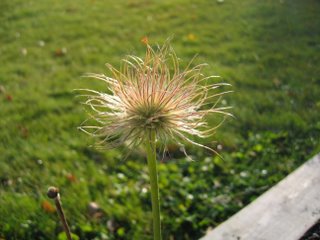



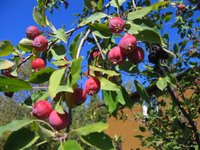
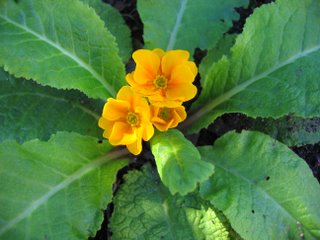





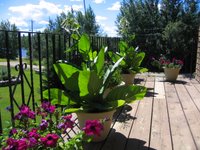
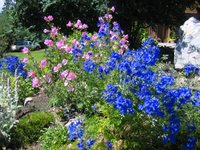
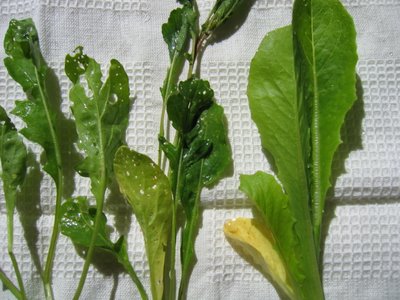



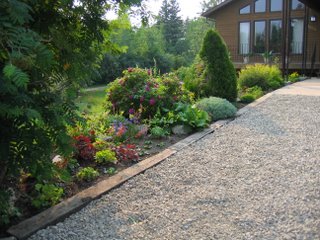
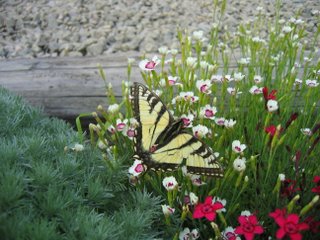
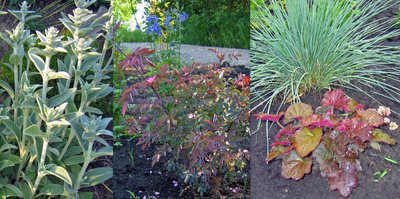 Other garden pearls from my yard: NEVER plant tansy. It is an invasive weed that even several applications of Round-up can't destroy. Any bit of root grows a new plant. Yarrow (Achillea millefolium) is a close second in that regard.
Other garden pearls from my yard: NEVER plant tansy. It is an invasive weed that even several applications of Round-up can't destroy. Any bit of root grows a new plant. Yarrow (Achillea millefolium) is a close second in that regard.
 Pictured:
Pictured: 